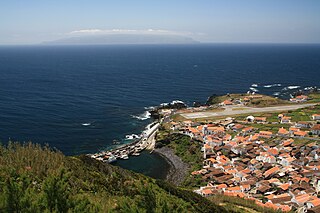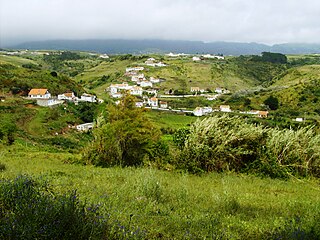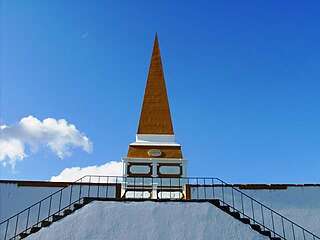
Vila do Porto is the single municipality, the name of the main town and one of the civil parishes on the island of Santa Maria, in the Portuguese archipelago of Azores. Its nearest neighbor, administratively, is the municipality of Povoação on the southern coast of São Miguel, and it is physically southwest of the islets of the Formigas. The population in 2011 was 5,552, in an area of 96.89 km².

Angra do Heroísmo, or simply Angra, is a city and municipality on Terceira Island, Portugal, and one of the three capital cities of the Azores. Founded in 1478, Angra was historically the most important city in the Azores, as seat of the Bishop of the Azores, government entities, and having previously served as the capital city of Portugal, during the Liberal Wars. The population in 2011 was 35,402, in an area of 239.00 km². It was classified as a World Heritage site by UNESCO in 1983.

Vila do Corvo is the smallest municipality in the Portuguese archipelago of the Azores, constituting the island of Corvo in its entirety. With a population of 430 in 2011, it is the least populated of the Portuguese municipalities, and the only Portuguese municipality, by law, without a civil parish. Its area is 17.11 square kilometres (6.61 sq mi).

Santa Cruz das Flores is a municipality situated in the north half of the island of Flores, in the Portuguese archipelago of the Azores. Situated in the sparsely populated Western Group, the population in 2011 was 2,289 inhabitants in an area that covers approximately 70.91 square kilometres (27.38 sq mi), bordering the southern municipality of Lajes das Flores.

Lajes das Flores is a municipality in the western part of the Azores; it includes the southern part of the island of Flores. To the north, where it is bordered by Santa Cruz das Flores. The population in 2011 was 1,504, in an area of 70.05 square kilometres (27.05 sq mi). Its municipal seat is in the parish of the same name.

Mosteiro is the smallest civil parish in the municipality of Lajes das Flores on the Portuguese island of Flores, in the archipelago of the Azores. The population in 2011 was 43, in an area of 5.99 square kilometres (2.31 sq mi).

Povoação is a municipality located in the southeastern corner of the island of São Miguel in the Portuguese archipelago of the Azores. The population in 2011 was 6,327, in an area of 106.41 km².

Almagreira is a civil parish in the municipality of Vila do Porto on the island of Santa Maria, in the Portuguese autonomous region of Azores. The population in 2011 was 599, in an area of 11.22 km². Bordering all other parishes of the island, it is located northwest of Vila do Porto.

Santo Espírito is a Portuguese civil parish, located in the municipality of Vila do Porto, in the autonomous region of Azores. The population in 2011 was 588, in an area of 26.68 km².

Santa Bárbara is a civil parish in the municipality of Vila do Porto in the Portuguese autonomous region of Azores. The population in 2011 was 405, in an area of 15.27 km².

Vila do Porto is a civil parish in the municipality of Vila do Porto, located on the island of Santa Maria, in the Portuguese autonomous region of Azores. It is the southernmost and easternmost parish in the archipelago of Azores. The population in 2011 was 3,119, in an area of 25.55 km².

The Watermill of Agualva is a watermill located in the civil parish of Vila Nova, in the municipality of Praia da Vitoria, island of Terceira, in the Portuguese Azores. It is part of the inventory of historical and religious buildings registered as an Inventário do Património Imóvel dos Açores dating back to the eighteenth century.

The Castle of Moinhos, officially known as the Castle of São Cristóvão, or Castle/Fort of São Luís is the name of the ruins of 16th-century fortification in city of Angra, on the Portuguese island of Terceira in the archipelago of the Azores. It is primarily known as the Castle of Moinhos, owing to the popular name given to the site for the number of mills that dotted the hilltop, on which the castle was erected.

The Convent of São Francisco is a Baroque-era convent and church in the historical centre of the city of Angra, civil parish of Sé, municipality of Angra do Heroísmo on the Portuguese island of Terceira, in the archipelago of the Azores. Better recognizable for the large Church of Our Lady of the Guide, is its locally known as the Igreja do Convento de São Francisco,, one of the largest of Christian temples in the Azores, and former seat of the Franciscan Province of São João Evangelista, during the Age of Discovery.
A Captaincy-General of the Azores (1766—1832) was a politico-administrative structure of governance imposed in the Azores on 2 August 1766, with its seat in Angra. It remained the de facto system of governance for 65 years, until it was abolished on 4 June 1832 by D. Peter IV, but by 1828 its de jure status had made it nonoperational, owing to the revolutionary movements that lead to the Liberal Wars. The creation of the Captaincy-General was part of the Pombaline reforms to the Portuguese administration, during the reign of Joseph I, under the initiatives of Sebastião José de Carvalho e Melo, the Marquess of Pombal, then prime minister. A Captaincy-General operated from the Palace of the Captains-General, under the direction of the titular Captain-General, who operated as the Governor of the Azores, with additional jurisdiction on every island of the Azorean archipelago. The Captaincy-General was succeeded by the Province of the Azores, an ephemeral administrative structure that was collapse in the immediate years.

The Fort of São João Baptista is the ruins of a 16th-century maritime fort situated on the western edge of Praia Formoso, in the civil parish of Almagreira, municipality of Vila do Porto, on the Portuguese island of Santa Maria.
João de Bettencourt de Vasconcelos was an aristocrat, who served as Captain-major of Angra, involved in the acclamation of John of Braganza, as King John IV of Portugal in the islands of the central group of the Azores, and in the expulsion of Spanish forces from the island of Terceira.

The Lighthouse of Ponta Negra is a beacon/lighthouse located along the cliffs of promontory of Ponta Negra, in the municipality of Vila do Corvo, on the Portuguese island of Corvo, in the archipelago of the Azores.

The Solar dos Tiagos is a solar in the civil parish of Topo, in the municipality of Calheta, on the Portuguese island of São Jorge in the archipelago of the Azores. The manor grounds contain a chapel notable as the burial place of Willem van der Haegen, an early settler of the Azores.

The Convent of Nossa Senhora da Conceição is a former convent situated in the civil parish of Sé, in the historic centre of the municipality of Angra do Heroísmo, in the Portuguese archipelago of the Azores.




















